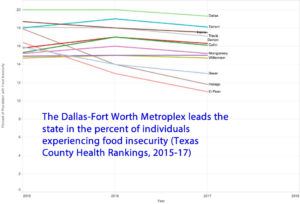Fighting Food Insecurity during National Nutrition Month
March 15, 2018 • community
School of Public Health & Texas Center for Health Disparities
Community Blog
As a health coach in a program for low-income residents of Fort Worth, I had the privilege of working with one client, Jim* who was motivated, smart, friendly, well-read, and a great conversationalist. His goal was to go back to school and study psychology to be able to work with adults and teenagers with mental health conditions. Having struggled with anxiety, depression and homelessness himself, he had a great deal of empathy for those with similar struggles. With Jim’s easygoing, friendly manner and his intelligence, it was clear that he would excel in whatever discipline he chose to pursue. I was excited for him to pursue his passion, and excited for the clients he would work with one day. I knew that once he finished school, he would be able to help a lot of people and be a positive influence in their lives.
 However, Jim’s lack of steady income and limited SNAP (Supplemental Nutrition Assistance Program) benefits meant he had to spend much of his free time riding the bus or walking to various food pantries in order to get enough to eat, leaving him with no time or energy to take the steps necessary to get back into school. The food insecurity Jim experienced had a domino effect in limiting his ability to go further in life—as a result, we’ll never know how many people he could have helped if he hadn’t faced a constant struggle to meet this most basic need for food.
However, Jim’s lack of steady income and limited SNAP (Supplemental Nutrition Assistance Program) benefits meant he had to spend much of his free time riding the bus or walking to various food pantries in order to get enough to eat, leaving him with no time or energy to take the steps necessary to get back into school. The food insecurity Jim experienced had a domino effect in limiting his ability to go further in life—as a result, we’ll never know how many people he could have helped if he hadn’t faced a constant struggle to meet this most basic need for food.
1 in 6 People struggle with Food Insecurity in Tarrant County
March is National Nutrition Month® and the theme this year is “Go Further with Food.” In 2016, 12.3 percent of U.S. households (41.2 million people) were food insecure—meaning that they had difficulty at some time during the year providing enough food for all family members because of a lack of resources. Texas’ food insecurity rate is higher than the nation at 14.3%. In the Tarrant County area, 1 of 6 people of all ages struggles with food insecurity and/or hunger, and 1 in 4 children come from families that live with uncertainty of where they will obtain their next meal.
With limited resources, food insecure families often end up buying low-cost, nutrient-poor foods. At the same time, intake of nutrient-poor foods increases the risk for underweight or obesity and micronutrient deficiencies. This may particularly affect young children causing increased hospitalizations, poor health, iron deficiency, developmental risk and behavior problems including primarily aggression, anxiety, depression, and attention deficit disorder. These problems may further increase children’s risk of poor school readiness, poor school performance and subsequent health disparities and poverty.
It’s imperative that we help food insecure families receive the resources they need to correct these deficits. Communities can build food security of healthy foods by getting everyone involved during National Nutrition Month Event Ideas® as well as utilizing sustainable sources throughout the year such as food banks, food pantries and even restaurants that address food insecurity. Tarrant Area Food Bank, Dallas Area Brighter Bites, and The Taste Project provide these services locally. Although many resources exist in the community, The Academy of Nutrition and Dietetics recommends people extend these resources by learning or teaching others to buy and prepare foods that “go further at home.” By helping people achieve food security, we can help people like Jim achieve their goals which helps nurture a healthy society both nutritionally and mentally while improving overall public health.

Contributors:
Teresa Wagner, DrPH, MS, CPH, RD/LD
Whitney Mollenhauer, Whitney has bachelor degrees in nutritional science and sociology. She has worked as both a health coach and project coordinator in a healthy lifestyle program for the homeless. Currently, Whitney leads a team of health coaches at the UNTHSC Health Pavilion.
Research reported in this publication was supported by the National Institute On Minority Health And Health Disparities of the National Institutes of Health under Award Number U54MD006882. The content is solely the responsibility of the authors and does not necessarily represent the official views of the National Institutes of Health.


Social media